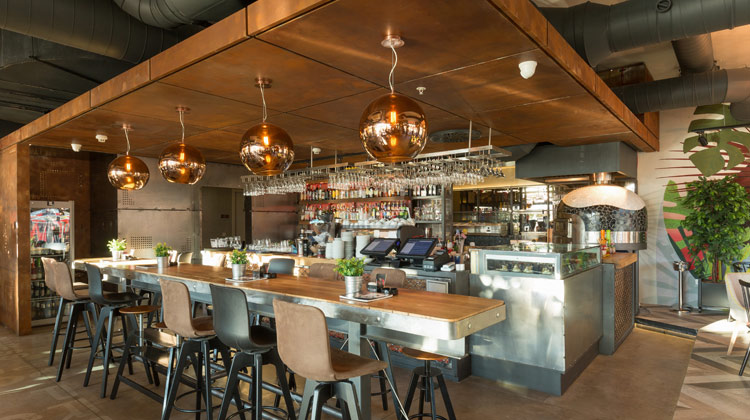Navigating Travel Industry Risks with Intelligent Communications
We’re going to explore some real-life unforeseen circumstances that the travel industry has had to navigate and how intelligent communications solut...

There’s no doubt that retail has seen a lot of drastic change in recent years. Advancements in technology introduced consumers to the world of online shopping and a pandemic,that forced everyone to stay at home, highlighted the benefits of shopping online to even the most dedicated high-street loyalists. As of 2023, the number of digital buyers is 2.64 billion – that’s 33.3% of the world’s population. To meet the demands of the modern customer, it’s important for retailers to embrace digital transformation.
However, what is digital transformation exactly? For many, digital transformation simply means the implementation of more up-to-date technology, but in reality, it’s so much more than that. It’s the integration of new technology, alongside more efficient processes and improved strategies that work together to improve business operations, enhance customer experiences and drive growth.
We’ve supported businesses within the retail industry to embrace digital transformation, so we’re going to take you through a clear explanation of what digital transformation is and demonstrate the benefits of embracing digital transformation for retail businesses.

Digital transformation: the process of using digital technologies to either improve existing or create new business processes.
This umbrella term is commonly used to cover a wide range of initiatives involving digital solutions, that businesses undertake to improve their operations, such as taking their services online or moving away from legacy technology to internet-based alternatives. However, new solutions are just the tip of the iceberg when it comes to a business’s digital transformation journey. It is the process of highlighting the changes that need to be made with new technologies, finding the right solutions to make these changes and creating or modifying policies and processes within a business to make the most from these solutions.
Digital transformation is often confused or used interchangeably with digitisation and digitalisation Although both of these terms are incorporated within the process of digital transformation, they are three completely separate concepts.
Digitisation is the conversion of analogue information to digital form. An example of digitisation would be converting information in paper format into digital Word documents. It’s key to differentiate that with digitisation it’s the information that is being digitised – not the processes.
When it comes to defining digitalisation, it’s not quite as cut and dry as digitisation. Simply defined, digitalisation is utilising digital technologies to adapt a system or process to incorporate computers or the internet.
Digital Transformation is where all business data is stored and utilised in a digital format (digitisation) and used to adapt systems and processes within a business (digitalisation) to enable a complete transformation of a business. It’s the sum of a range of projects involving digitisation and digitalisation that all add up to allow a business to become more agile, efficient and prepared for any potential change the future can throw at them.
In a nutshell, to achieve digital transformation, a business needs to undertake the digitisation of data, to utilise in the digitalisation of analogue processes, to digitally transform a business, its operations and the experience of its customers.
So, now we’ve gone through the process of digital transformation, let’s explore what it means for the retail industry. To start, we will need to jump in the DeLorean and go back in time to a world before we relied so heavily on digital technology. In this world, stock checks involved pen, paper and a clipboard. Consumers could only view the goods of a shop in-person or via a limited selection shown in advertisements on television or in magazines. If a customer needed to know if an item was stocked in a particular size or colour, they had to rely on someone to physically check an on-premise storeroom. Today, consumers expect to be able to see the full range of a retailer’s offerings, the availability of items in stock and the ability to have those items delivered with the click of a button. Providing these capabilities and staying ahead of the competition in a saturated market depends on embracing digital transformation effectively within a business.

Short answer? Yes. The way forward is going to be digital and internet-based. There’s no way around it. For a customers, moving across to digital and offering online shopping capabilities is vital, alongside enabling a variety of communication options in order to provide the best experience. For teams, making the move to digital, internet-based solutions provide the tools they need to effectively support customers, complete duties and work efficiently. Relying on outdated technology prevents businesses from staying ahead of competitors and causes frustration within workplaces, as keeping up with customer demand becomes unattainable due to not having the right solutions for the job.
However, it’s not a one-size-fits all project. Digital transformation will look different for every business, as the point of embarking on this journey is to bolster and adapt existing business models and operations with digital technologies and related processes.
A good example of a brand that have realised the importance of embracing digital transformation in order to remain competitive is Primark. This well-known fashion retailer became popular thanks to its large variety of stock and low price. I is one of the few brands that have been able to thrive on solely on-premises sales. Their ‘store-first’ model has worked incredibly well, so much so that they didn’t need to invest in e-commerce solutions at all. When the pandemic arrived and many brands felt the pressure, even with online retail capabilities, Primark saw a strong recovery and continued their store-first strategy – an impressive feat, given that many of their counterparts, that had already invested in e-commerce solutions, took a hit following the pandemic.
The demand for online retail has always been there from Primark’s customer base, with social media posts being flooded with comments asking when they will open an online store. Yet, despite this demand, Primark have continued to resist opening an e-commerce site in order to keep costs low. That is until 2022, when the company took their first main step into creating new digital capabilities with the launch of a customer-focussed website. Although this initial step in improving Primark’s digital strategy still didn’t venture into offering e-commerce features, it was a vast improvement on their previous website, which only displayed a list of items without any details, such as sizing and didn’t possess delivery capabilities. Their new site not only offers item details, it also allows customers to check stock in specific stores and a click and collect service on a limited range of items.
Taking a business online requires investment in digital transformation. From implementing software and smart devices to track and report on stock in real-time, so customers can view the items that are available to capturing customer data via digital solutions in order to support digital marketing initiatives to promote the website. The move to digital solutions has already played a positive role within Primark’s business, with increased footfall into stores from both existing and new customers. Taking their business online would not have been possible without the investment of key digital technology, as Primarks CIO, Andrew Brothers stated:
“The new site is underpinned by a modern and flexible technology architecture to give our customers the best user experience”.
Harnessing the power of digital solutions has enabled Primark to satisfy their customer’s needs, drive new business and pave the way for future initiatives. It’s a true example of how a business can keep their existing business model and enhance their existing offerings with digital technology.
Primark is just one example of how digital transformation can benefit retail businesses. From better customer experiences to streamlined operations and detailed data driving better decisions, there are a variety of benefits that digital transformation can provide.
Data protection is a prime concern for all customers. With businesses storing customer information, including addresses, contact details and financial information, strong security measures are vital for ensuring customer trust. Digital solutions involve robust security measures that keep business and customer data more secure. Cloud computing allows secure storage and access to data and enables automation of menial tasks that can reduce human error. Moving business data to the cloud enables you to encrypt sensitive information and bolster security processes with robust data protection solutions. You can limit access to data to relevant personnel, limiting the amount of access points and potential gateways for hackers. It also means the chance of data being deleted or modified by accident is reduced. Cloud computing also offers secure data backups – should data be deleted or a disaster strikes, information can be recovered quickly and easily.
Communications become more secure when digital solutions are utilised. Internet-based solutions, like hosted phone systems and UCaaS, provide a level of protection that isn’t offered by analogue solutions. Businesses can strengthen security around communications by enabling solutions like multi-factor authentication to access communication platforms and data stored within those platforms.
Customer loyalty is not as reliable as it once was. Markets across the retail sector are saturated with hundreds of brands competing for attention, so gaining a competitive edge is more vital than ever. The biggest differentiator for customers? Experience. Writing for Forbes, Daniel Newman, CEO of Futurum – a family of research groups – 86% of customers are willing to pay more for a better experience. When it comes to staying ahead of the competition, product alone isn’t the deciding factor. It’s the service you provide along with your product that adds value and sets you apart from the rest.
Streamlined operations, better access to data and improved communications are factors that add up to a better customer experience. Teams having quicker access to data thanks to cloud computing, smart devices linked to the Internet of Things and digital communication solutions, means they can provide a more efficient and knowledgeable service. Should customers need advice, switching to digital communication platforms enables them to interact with a business in a way that suits them the best. Having streamlined communication channels with comprehensive IVR systems and intelligent call queueing means customers can trust that they will be able to speak to the person they need, quickly and efficiently.
Digital technologies enable retailers to streamline inventory management processes. Improved processes result in accurate inventory records, which can fuel more informed customer experiences, easier order management and reduced stock-outs. The synergy of utilising IoT devices with cloud computing means you have clear, up-to-date visibility on key data that can fuel a more informative service and innovative features within stores. Using IoT-enabled solutions like RFID tags and sensors allows retailers to track inventory in real-time allowing better decisions making when purchasing stock, reducing the time in which items are out of stock and enabling customers to see available stock.
Utilising digital solutions allows retailers to gather and analyse in-depth data to gain valuable insights on consumer behaviour, relationship management, customer journeys and more. This data allows businesses to make better decisions to drive efficiency, improve marketing efforts and enhance customer experiences.
Cloud computing allows access to in-depth data from a range of different sources across a retail business. From how customers navigate a retailer’s website to how marketing initiatives are performing, businesses have access to a plethora of data that can be used to improve operations, drive better customer experiences and create marketing campaigns that convert. Furthermore, integrating CRM systems within a UCaaS platform allows key decision makers to have visibility on a customer’s journey within a business, as well as manage in-house resource more effectively for streamlined customer services.

Examples of how retailers are already taking advantage of digital technologies to provide a better experience for their customers can be found within the shop floors of Zara and River Island.
Like most brands these days, Zara have an app that customers can use to find items, stock information and to order online. Nothing out of the ordinary. However, their ‘store mode’ feature is capturing attention and putting them ahead of other retailers. Using ‘store mode’ allows customers to have access to more innovative experiences including:
Utilising digital technologies, as well as a dedicated smart phone application has enabled Zara to provide an experience for their customers that is more convenient and involves less wait time. Simultaneously, they have encouraged footfall within stores and have increased the chances of sales by enabling customers to spend the time they would have wasted standing in queues, browsing their shop floor instead.
River Island haven’t just implemented one new technology, they have introduced an entirely new store format called ‘River Studios’. This new concept involves ‘next-generation’ smart fitting rooms that will identify the customer’s products and a touch screen for customers to choose more sizes, alternative styles or request help from one of the in-store stylists, without having to leave the fitting room!
This innovative store setup demonstrates the synergy of utilising multiple digital solutions, such as cloud computing, RFID tags within IoT and communications technology to provide a seamless experience.

Chantelle Lighting are a family-owned, decorative lighting manufacturer and retailer with 30 years’ experience providing high-quality, luxury lighting. Following challenges highlighted by the pandemic, Chantelle Lighting were looking to move their business away from legacy technology and onto digital solutions. They required their communications and business applications to be moved into the cloud to future-proof their business, safeguard their data and enable their team to work more efficiently from any location.
Elite Group provided an 8×8 cloud communications solution which enabled the team at Chantelle Lighting to work and collaborate effectively, whether they were working from home or in the office. This feature-rich communications system also allowed Chantelle Lighting to expand their search when it came to recruitment, as they weren’t restrained by location when looking for new talent to join the business. We then provided a resilient, leased line connectivity solution, which enabled Chantelle Lighting to move their business to the cloud, for streamlined operations, improved data security and the ability to provide an even better service for their customers.
Read the full Chantelle Lighting case study.
Ready to start your digital transformation? Our team of technology experts are here to help. Whether you’re looking to upgrade or invest in new technologies, Elite Group can provide the latest solutions with expert advice, pro-active management and comprehensive support. Fill out our contact form today or call 0344 875 8880.